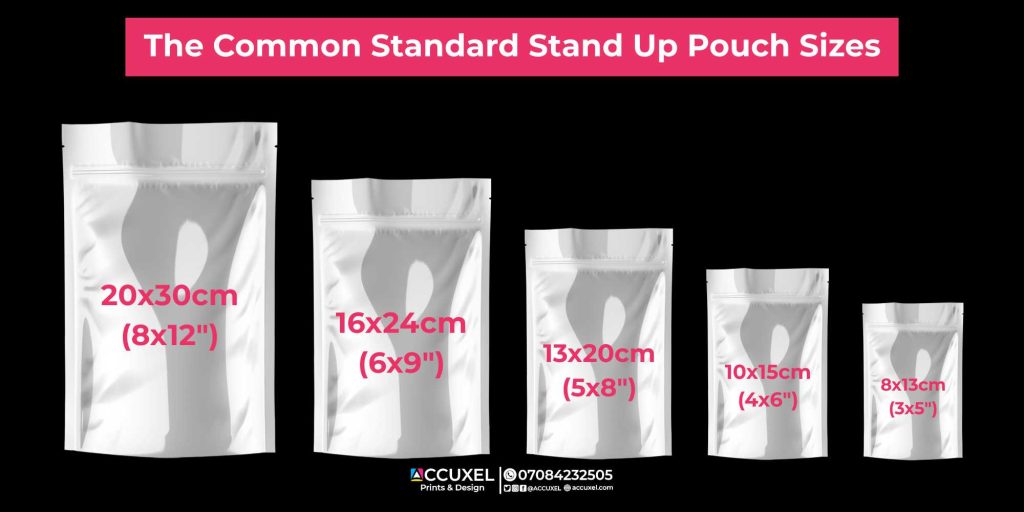Stand-up pouches have become a mainstay in modern packaging, gaining popularity for their practicality and versatility. These flexible containers, from snack foods to cosmetics, are now ubiquitous in various industries. They offer an appealing mix of lightweight structure, portability, and durability, making them highly adaptable for small businesses and large corporations.
In today’s fast-paced consumer environment, packaging matters more than ever. It’s not just about protection but also aesthetics, convenience, and sustainability. Stand-up pouches address all these concerns with their sleek design and customizable features, but one key aspect that can’t be overlooked is their sizes. The size of a stand-up pouch plays a crucial role in ensuring product safety, cost efficiency, and branding success.
Table of Contents
ToggleWhy Choose the Right Flexible Stand-Up Pouch Packaging Size?
Let’s face it, folks, size matters, especially when it comes to stand-up packaging pouches! But before you start thinking bigger is always better, choosing the right stand up pouch size isn’t just about fitting your product, it’s an actual game-changer for your brand.
Let’s break it down:
- Shelf Appeal: Do you want to stand out or blend in? Packaging is the silent salesman. The right size catches the eye and tells your product’s story. You might want to consider your competitors’ sizes so you can properly decide if you want to stand out or fit in.
- Cost-Effectiveness: Saving Pennies, Making Dollars. With flexible packaging pouches, larger isn’t always better. Rightsizing can cut costs on materials and shipping. It’s always best to calculate your “air-to-product ratio” to optimize pouch size.
- User Experience: Happy Customers, Repeat Business. Think beyond the shelf. How will your customers use and store your product? You should test different sizes with focus groups for real-life feedback.
The perfect size balances visual appeal, practicality, and profitability. It’s not just about containing your product, it’s about elevating your brand.
What Makes a Stand Up Pouch Size “Standard”?
it’s not as cut and dry as you might think! Industry norms, customer demands, and purchasing power play a big role here. As we love to say, “Standard sizes are a result of manufacturing efficiency and market demand.” Typically, you’ll see small (10x15cm), medium (13x20cm), and large (16x24cm) stand-up pouches dominating store shelves.
But why these sizes, you ask? Well, it’s all about practicality. Standard sizes fit neatly on store shelves, pack efficiently for shipping, and often align with common product volumes. Plus, they’re cost-effective to produce in bulk.
Here’s a pro tip: When choosing a pouch size, consider your product’s density. A light, fluffy snack like plantain chips might need a larger pouch than a dense granola, such as chinchin and peanuts, even if they weigh the same.
Remember, “standard” doesn’t mean “only option.” Many brands find success with slight variations or custom sizes. The key is balancing uniqueness with the practical benefits of standardization.
Want To Print Something?
Ultimately, the right size depends on your product, target market pocket, and business goals. Standard sizes offer a great starting point, but don’t be afraid to think outside the pouch!
Breaking It Down: Common Standard Stand Up Pouch Sizes
When it comes to standard sizes, stand-up pouches come in a variety of dimensions to cater to different product requirements. The most common sizes range from small 50g powder (8x13cm) pouches used for single servings or samples to larger pouches holding up to 1kg powder (20x30cm) for bulkier products.
Below are the common standard stand-up pouch sizes in centimeters for better measurement accuracy:
- 8x13cm (50g powder): Also known as a 3×5 inch pouch. This mini standard pouch size is ideal for pieces of jewelry, single-use cosmetics, or small food portions.
- 10x15cm (100-150g powder): Also known as a 4×6 inch pouch. This small standard pouch size is commonly used in the food industry for coffee powder, tea, and dry snacks.
- 13x20cm (200-250g powder): Also known as the 5×8 inch pouch. These medium flexible pouch sizes are perfect for goods like pet food, granola, or detergents.
- 16x24cm (450-500g powder): Also known as a 6×9 inch pouch. This large, flexible pouch is ideal for items like potato chips, plantain chips, nuts, or popcorn.
- 20x30cm (1kg powder): Also known as the 8×12 inch pouch. This is the go-to stand up pouch size when packaging dry goods, snacks, or food products in large quantities.
While these sizes are standard, custom sizes are also available. Most businesses we work with often request bespoke dimensions to align with their branding strategies or to fit specific product volumes. Customization allows companies to stand out in competitive markets, particularly in sectors like organic food or luxury cosmetics, where unique packaging is part of the company’s product appeal.

Challenges in Choosing the Right Pouch Size
Selecting the correct stand-up pouch size can be challenging for businesses, as it involves several considerations. The volume and weight of the product must be matched to the pouch’s capacity to avoid overfilling or underfilling. Overfilled pouches can lead to bursting, damage, or spoilage, while underfilled pouches will feel too light and might not present well on retail shelves.
To top that, different products have unique needs. Liquids may require spouted pouches for easier dispensing, while dry goods like chinchin, plantain chips, nuts, or coffee might need pouches with resealable zippers to maintain freshness. Thus, understanding your product’s characteristics is essential in choosing the appropriate pouch size.




